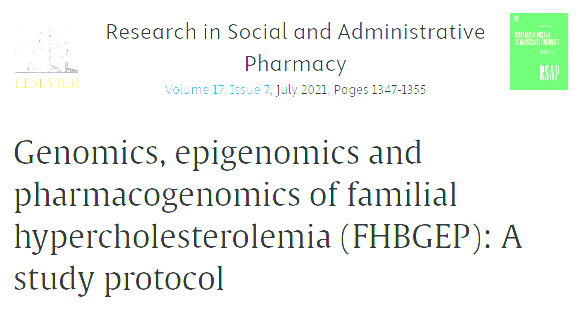Identification of pathogenic variants in the Brazilian cohort with Familial hypercholesterolemia using exon-targeted gene sequencing
Familial hypercholesterolemia (FH) is a monogenic disease characterized by high plasma low-density lipoprotein cholesterol (LDL-c) levels and increased risk of premature atherosclerotic cardiovascular disease. Mutations in FH-related genes account for 40% of FH cases worldwide. In this study, we aimed to assess the pathogenic variants in FH-related genes in the Brazilian FH cohort FHBGEP using exon-targeted gene sequencing (ETGS) strategy. FH patients (n = 210) were enrolled at five clinical sites and peripheral blood samples were obtained for laboratory testing and genomic DNA extraction. ETGS was performed using MiSeq platform (Illumina). To identify deleterious variants in LDLR, APOB, PCSK9, and LDLRAP1, the long-reads were subjected to Burrows-Wheeler Aligner (BWA) for alignment and mapping, followed by variant calling using Genome Analysis Toolkit (GATK) and ANNOVAR for variant annotation. The variants were further filtered using in-house custom scripts and classified according to the American College Medical Genetics and Genomics (ACMG) guidelines. A total of 174 variants were identified including 85 missense, 3 stop-gain, 9 splice-site, 6 InDel, and 71 in regulatory regions (3'UTR and 5'UTR). Fifty-two patients (24.7%) had 30 known pathogenic or likely pathogenic variants in FH-related genes according to the American College Medical and Genetics and Genomics guidelines. Fifty-three known variants were classified as benign, or likely benign and 87 known variants have shown uncertain significance. Four novel variants were discovered and classified as such due to their absence in existing databases. In conclusion, ETGS and in silico prediction studies are useful tools for screening deleterious variants and identification of novel variants in FH-related genes, they also contribute to the molecular diagnosis in the FHBGEP cohort
Authors
Borges JB, Oliveira VF, Dagli-Hernandez C, et al.
External link
Publication Year
Publication Journal
Associeted Project
Microbiology or Immunology
Lista de serviços
-
Genomic analyses reveal broad impact of miR-137 on genes associated with malignant transformation and neuronal differentiation in glioblastoma cells.Genomic analyses reveal broad impact of miR-137 on genes associated with malignant transformation and neuronal differentiation in glioblastoma cells.
-
RNA-Binding Protein Musashi1 Is a Central Regulator of Adhesion Pathways in Glioblastoma.RNA-Binding Protein Musashi1 Is a Central Regulator of Adhesion Pathways in Glioblastoma.
-
MicroRNA Transcriptome Profiling in Heart of Trypanosoma cruzi-Infected Mice: Parasitological and Cardiological Outcomes.MicroRNA Transcriptome Profiling in Heart of Trypanosoma cruzi-Infected Mice: Parasitological and Cardiological Outcomes.
-
Genome mapping and expression analyses of human intronic noncoding RNAs reveal tissue-specific patterns and enrichment in genes related to regulation of transcription.Genome mapping and expression analyses of human intronic noncoding RNAs reveal tissue-specific patterns and enrichment in genes related to regulation of transcription.
-
Antimicrobial peptide LL-37 participates in the transcriptional regulation of melanoma cells.Antimicrobial peptide LL-37 participates in the transcriptional regulation of melanoma cells.
-
Down-regulation of 14q32-encoded miRNAs and tumor suppressor role for miR-654-3p in papillary thyroid cancer.Down-regulation of 14q32-encoded miRNAs and tumor suppressor role for miR-654-3p in papillary thyroid cancer.
-
Integration of miRNA and gene expression profiles suggest a role for miRNAs in the pathobiological processes of acute Trypanosoma cruzi infection.Integration of miRNA and gene expression profiles suggest a role for miRNAs in the pathobiological processes of acute Trypanosoma cruzi infection.
-
Integrative Biology Approaches Applied to Human DiseasesIntegrative Biology Approaches Applied to Human Diseases
-
Proteomics reveals disturbances in the immune response and energy metabolism of monocytes from patients with septic shock.Proteomics reveals disturbances in the immune response and energy metabolism of monocytes from patients with septic shock.
-
Genomics, epigenomics and pharmacogenomics of Familial Hypercholesterolemia (FHBGEP): A study protocol.Genomics, epigenomics and pharmacogenomics of Familial Hypercholesterolemia (FHBGEP): A study protocol.
-
Melatonin-Index as a biomarker for predicting the distribution of presymptomatic and asymptomatic SARS-CoV-2 carriersMelatonin-Index as a biomarker for predicting the distribution of presymptomatic and asymptomatic SARS-CoV-2 carriers
-
Profiling plasma-extracellular vesicle proteins and microRNAs in diabetes onset in middle-aged male participants in the ELSA-Brasil study.Profiling plasma-extracellular vesicle proteins and microRNAs in diabetes onset in middle-aged male participants in the ELSA-Brasil study.
-
Big Data and machine learning in cancer theranosticsBig Data and machine learning in cancer theranostics
-
Genomic positional conservation identifies topological anchor point RNAs linked to developmental loci.Genomic positional conservation identifies topological anchor point RNAs linked to developmental loci.
-
Integrative systems immunology uncovers molecular networks of the cell cycle that stratify COVID-19 severityIntegrative systems immunology uncovers molecular networks of the cell cycle that stratify COVID-19 severity

